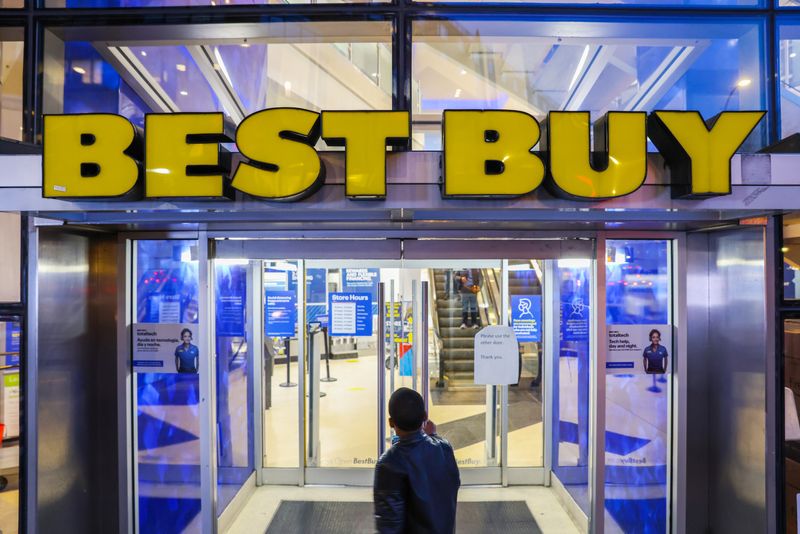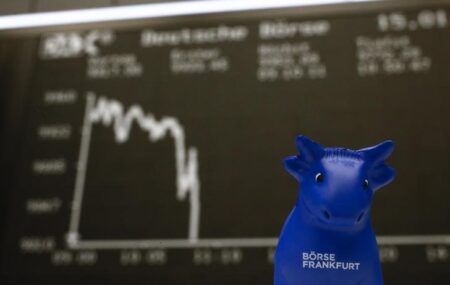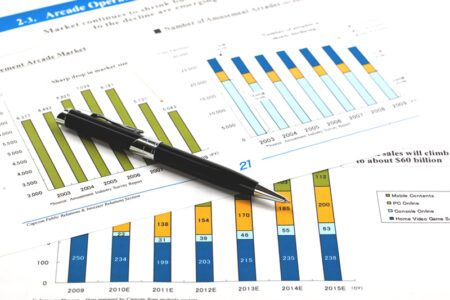Investing.com — Here is your Pro Recap of the top takeaways from Wall Street analysts for the past week: upgrades for Best Buy , Lululemon and Collegium Pharma; downgrade for Maxeon Solar and Medifast.
InvestingPro subscribers always get first dibs on market-moving rating changes.
Best Buy
What happened? On Monday, Citi double upgraded Best Buy (NYSE:) to Buy with a $100 price target.
What’s the full story? Citi is double upgrading BBY shares from Sell to Buy. The research team believes that the catalyst path looks positive from here with upside potential to both earnings and valuation. This is based on tech replacement cycles underway, new AI innovation providing incremental demand, and margin execution remaining solid.
Last week’s 1QF25 earnings print proved GM execution remains best-in-class with company specific drivers able to offset external pressures like higher promotional activity. Simply put, that was a thesis changer versus Citi’s prior negative thesis. The research team acknowledges 2H SSS risk in the face of consumer uncertainty (election distraction and shortened holiday calendar).
However, Citi believes it’s prudent to look at the multi-year opportunity ahead as the business returns to growth and an attractive margin expansion story develops. The research team is raising their TP to $100 (from $67) based on higher EPS estimates (sales & margin led) and a raised target multiple of 14x FY26 EPS.
Buy at Citi means “Buy (1) ETR of 15% or more or 25% or more for High risk stocks.”
How did the stock react? Best Buy opened the regular session at $85.96 and closed at $86.94, a gain of 2.50% from the prior day’s regular close.
Maxeon Solar Technologies
What happened? On Tuesday, Goldman Sachs double downgraded Maxeon Solar Technologies Ltd (NASDAQ:) to Sell with a $1 price target
What’s the full story? Goldman Sachs has revised its stance on MAXN following the company’s earnings report for 4Q23 and 1Q24, released on May 30. The report showed that both gross margins and EBITDA fell short of GSe/Factset consensus expectations, leading to a weaker-than-anticipated guidance for 2Q24 and the full year of 2024. Additionally, MAXN has yet to secure the DOE loan, and in a surprising move, announced an equity investment from TZE. This investment, coupled with a debt restructuring plan, is expected to significantly alter MAXN’s capital structure. The proposed issuance of new shares is likely to dilute the value for current shareholders, with TZE’s ownership set to exceed 50.1% post-transaction, and nearly 350 million convertible shares becoming active.
The research team at Goldman Sachs points out that while the equity investment and debt restructuring should mitigate liquidity concerns amid challenging market conditions, there remains increased uncertainty regarding future funding, including the DOE loan guarantee. Given the combination of market weakness, soft guidance, risks associated with future capacity additions and timing, as well as the uncertainty and potential dilution risk of the capital structure as MAXN addresses its liquidity issues, Goldman Sachs has downgraded MAXN from Buy to Sell. The firm has also adjusted its 12-month target price for MAXN to $1, which represents a 46% downside, in contrast to the approximately 22% upside previously projected across its coverage.
Sell at Goldman means “Being assigned a Buy or Sell on an Investment List is determined by a stock’s total return potential relative to its coverage universe.”
How did the stock react? Maxeon Solar Technologies opened the regular session at $1.76 and closed at $1.75, a decline of 5.41% from the prior day’s regular close.
Medifast
What happened? On Wednesday, DA Davidson downgraded Medifast (NYSE:) to Underperform with $17.50 price target
What’s the full story? The downgrade follows a meeting with Medifast, which prompted a shift in revenue projections—now expecting a sequential flattening in the first quarter of 2025 instead of the fourth quarter of 2024. Consequently, estimated sales for 2025 have decreased by 5% year-over-year, and the projected earnings per share (EPS) have been cut by 29%.
Medifast’s advertising campaign for its GLP-1 offering, initially scheduled for June, has been delayed to July. The impact of these ads on customer acquisition won’t be disclosed until November. With the stock down 64% year-to-date, DA Davidson suggests the possibility of further decline. Medifast’s current marketing spend (5%-6% of sales) is notably lower than that of weight loss and telehealth competitors (25%-50% of sales), raising concerns about its competitive position
Underperform at DA Davidson means “Expected to lose value of over 15% on a risk adjusted basis over the next 12-18 months.”
How did the stock react? Medifast opened the regular session at $20.43 and closed at $22.02, a decline of 8.30% from the prior day’s regular close.
Lululemon
What happened? On Thursday, HSBC upgraded Lululemon Athletica Inc (NASDAQ:) to Buy with a $425 price target.
What’s the full story? HSBC analysts report that Lululemon experienced a remarkable stock surge but faced challenges after reaching an all-time high in January 2024. Doubts about North American growth resilience led to concerns, and the company’s March guidance missed consensus expectations—a significant departure from its consistent “beat and raise” pattern. Consequently, the stock has declined 40% year-to-date, contrasting with a more stable sporting goods sector.
While Q1 “Americas” comparable sales remained flat, some of the pain was self-inflicted due to inventory shortages in various colors and sizes, particularly in women’s products. However, global comparable sales increased by 7%, driven by strong performance in mainland China and other international markets. Although the Americas still account for 73% of group sales, the surge in international sales suggests a potential scenario where international revenue reaches half of the group’s business.
Despite limited earnings revisions, the recent multiple compression has led to what analysts consider an overly punished stock
How did the stock react? Lululemon opened the regular session at $337.23 and closed at $323.03, a gain of 4.91% from the prior day’s regular close.
Collegium Pharma
What happened? On Friday, Jefferies upgraded Collegium Pharmaceutical Inc (NASDAQ:) to Buy with a $44 price target.
What’s the full story? Jefferies has expressed a more bullish view on COLL, which is currently trading at just 4x EBITDA following the departure of the CEO. The firm believes that the risk/reward ratio skews to the upside. This optimistic view is driven by several factors. Firstly, Jefferies notes that the 2Q trends appear strong and the consensus EBITDA is likely too low. Secondly, the firm believes that the upside around LOEs (base case) is underappreciated.
Furthermore, Jefferies highlights the significant cash generation expected through 2028, predicting that net cash will eclipse the market cap in F28. As a result of these factors, the firm has upgraded COLL to a Buy with a $44 price target. This target is based on an equal weighting of 5xC25 adjusted EBITDA and a DCF analysis. Despite the recent leadership changes, Jefferies sees potential for growth and profitability in COLL’s future.
Buy at Jefferies means “Describes securities that we expect to provide a total return (price appreciation plus yield) of 15% or more within a 12-month period.”
How did the stock react? Collegium Pharma opened the regular session at $32.62 and closed at $33.19, a gain of 5.84% from the prior day’s regular close.
Read the full article here
















